| 1 | Found in spacious Florida woodlands |
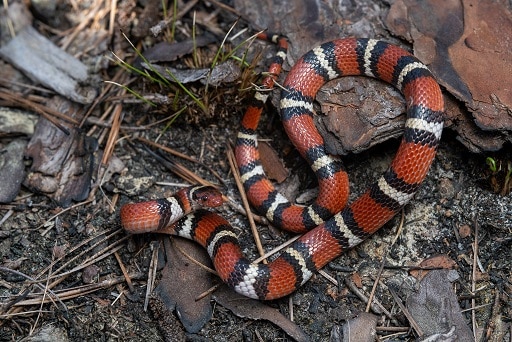
The scarlet kingsnake is a harmless species that lives in forests of the southeastern USA. Its stronghold is Florida, where it’s found in every county except the Keys, and they also live in Georgia, North Carolina and Alabama.
This isn’t a snake which people bump into crossing the road, as even dedicated herpers can spend months trying to track one down. It does however, appear in garden swimming pools occasionally. Scarlet kingsnakes mainly live in sparse to moderate forests, and are a semi-burrowing snake which spends much of its time below the soft forest floor, enlarging tunnels made by small mammals. They’re also a nocturnal snake, adding to the difficulty in finding them.
That said, there’s one secret way to find scarlet kingsnakes that’s amazingly effective. Within forests, a scarlet kingsnake’s favourite spot isn’t below fallen leaves, or piles of rocks, but in the loose bark of dead trees. They particularly love rotting bark on the stumps of old pine trees, wedging themselves in the tight gaps (probably surrounded by woodlice). Both standing and fallen pine trees are fine, and anyone searching for a scarlet kingsnake should head to those trees first. In southern Florida, one of their favourite trees is the introduced Australian pine.
| 2 | Wedges itself between tree bark |
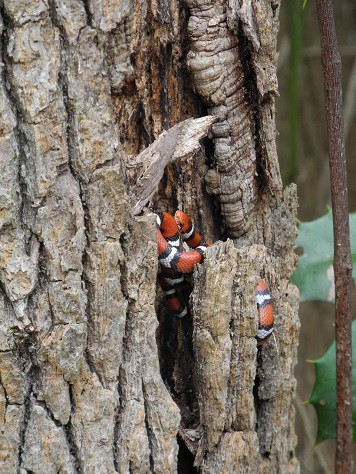
Scarlet kingsnakes are notorious for being mistaken for the eastern coral snake, which is an uneasy neighbour in their forest floor domain. Both have red, black and yellow bands and small beady eyes. Like the similarly-coloured scarlet snake, this inspired a nursery rhyme with about 1000 incarnations. The standard is “red touches black, venom lack” followed by “red touches yellow, kill a fellow”, referencing the ordering of the pair’s bands. The rhyme is completely accurate, as scarlet kingsnakes generally follow a sequence of red, black, yellow, black, red, black, yellow, black, continued to eternity.
Catchy rhymes aside though, a really obvious giveaway is that scarlet kingsnakes have a red face and chin. An eastern coral snake’s face is pure black, so black that the eyes are barely distinguishable.
Another secret sign is that with the eastern coral snake’s bands, they join at the belly, barely changing in appearance compared to their back. With the scarlet kingsnake, the bands almost touch, but there’s always a thin white line separating them. Their bellies also have checkered markings sometimes.
| 3 | Harmless, but misidentified |
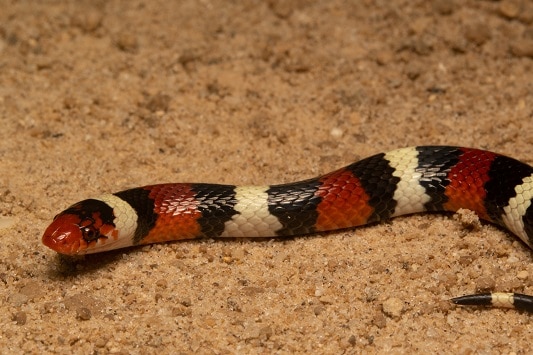
Eastern coral snakes are also longer, averaging at 80cm with a record of 129.5cm (in 1996). Scarlet kingsnakes average at 50cm and the maximum on record measured just 68.6cm. With scarlet kingsnakes, the red patches are easily the largest, while eastern coral snakes have equally large red and black patches (only the yellow bands are thin).
The older the scarlet kingsnake, the trickier distinguishing the two becomes. As youths, the yellow patches are pure white, but the longer they survive, weaving past bird predators and growing centimetres each year, the more pigment accumulates in these stripes and the yellower they become. The yellowing begins at 3 months, and continues imperceptibly.
There’s also geographical variation, as some spots have whiter bands while other unpredictable locations are yellow. The shade varies significantly, from lemon yellow to the intensity of an apricot. Each stripe itself can have varying colours, being pale near the belly and darkening closer to their spine. Meanwhile, a scarlet kingsnake’s red and black bands are constant throughout their lives.
| 4 | Diet: specialises in lizards |
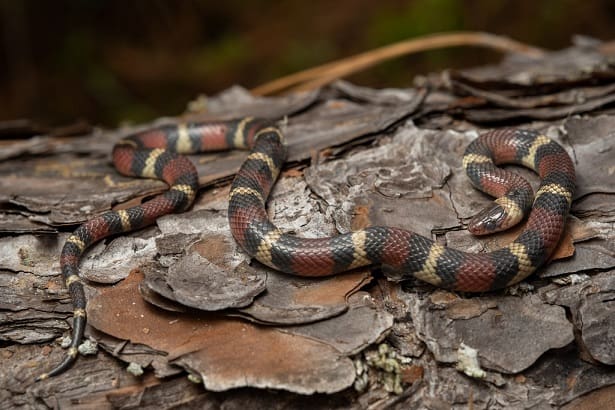
The scarlet kingsnake isn’t a species that slithers around and mindlessly swallows everything up without even blinking. Few animals meet its strict requirements. Instead, scarlet kingsnakes get most of their meals from skink lizards.
As a percentage of their diet, they’re the top skink eater of any North American snake. They’re wildly different from their close milk snake (Lampropeltis triangulum) relative, which is a heavy mammal muncher. This is one reason why scarlet kingsnakes were separated into their own species. To help them in their quest, scarlet kingsnakes have enlarged anterior teeth, like other skink specialists around the world.
The best study so far investigated old, stored museum specimens of scarlet kingsnakes. The main conclusion was that the species’ diet was far narrower than previously thought. Of 42 food items found, 74% were skinks, while 15% were snakes. A single mouse was found as well, as was a set of skink eggs. Two skink species were clearly dominant above the rest: the ground skink and southeastern five-lined skink.
| 5 | Occasionally feeds on snakes |
Another discovery was that 97% of the scarlet kingsnake’s diet was elongated, rather than bulky and round. This is because scarlet kingsnakes have a small gape size; they cannot open their mouths very far. Scarlet kingsnakes are a snake-eating snake as well. They’re limited by a small size (a maximum of 75cm), but the study itself found the following snakes in their bellies: ring-necked snake, rough earth snake, garter snake (species undetermined) and southeastern crowned snake.
One tale happened in Forrest county, Mississippi in 2005. A researcher found a scarlet kingsnake lodged in the bark of a fallen longleaf pine, which spooked the snake, and forced it to regurgitate two small ring-necked snakes. This species also likes forests, and is similarly fond of old rotting bark, so it’s not surprising that they come face to face. The ring-necked snakes measured 15-20cm, while the scarlet kingsnake measured 40cm.
24 hours later, the researcher returned to the scene of the crime. The plot thickened, as the scarlet kingsnake was still lodged in the bark, but the ringneck snakes’ were nowhere to be seen. The scarlet kingsnake also had an odd bulge in its stomach. No-one was able to answer this riddle.
| 6 | Copycat or pure coincidence? |
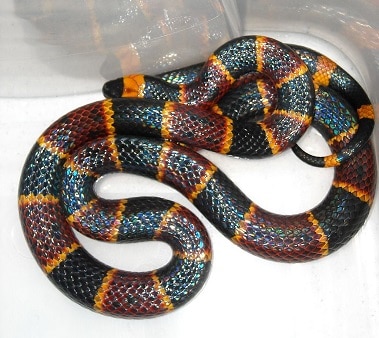
The obvious theory about the similar colours is that eastern coral snakes (pictured above) are venomous, and that scarlet kingsnakes evolved to mimic them. This would protect them against birds without lifting a finger, with the hard gruelling work done during evolution, leading them to reap the rewards forever.
But another theory is that scarlet kingsnakes evolved to mimic a shadowy forest floor. The species moves at night, and in darkness, the bands perfectly mimic moonlit areas alternating with dark patches. The eastern coral snake also lives in forests, and might have evolved its patterns for the same reason. Essentially, the two developed independently of each other because of the same habitat pressure, rather than copying each other.
A sign that the colours are a mimic is that scarlet kingsnakes have very few broken tails. This is a classic sign of predator attack in adult snakes, which most can survive for years, but scarlet kingsnakes have a particularly low rate of missing tails (the eastern ribbon snake has a particularly high rate). Likewise, it’s rare for eastern coral snakes to have broken tails as adults.
| 7 | Strangely similar pigments |
Another possibility is a combination – that the scarlet kingsnake’s colours evolved because of the forest floor originally, then accelerated as they gained protection from predators by accident.
Another study examined a spot in North Carolina where eastern coral snakes mysteriously went extinct in 1960. Not only did the scarlet kingsnakes keep their protection, it actually strengthened. The local predators still had the instinct to avoid red, black and yellow bands.
Scarlet kingsnakes even possess the exact same pigments making up the red, yellow and black colours. Yellow can be produced by many pigments in nature, such as sepiapterin or xanthopterin. Human skin, for example, has yellowness determined by carotenoids, which is why too many carrots can turn you orange. However, both scarlet kingsnakes and eastern coral snakes use pteridines for their yellow bands. For black, they both used eumelanin sequestered within melanosomes, and for red they both used drosopterin. The two snakes also possesses an extensive layer of guanine crystals below the yellow bands, which amplified the colour. These crystals only had minor differences in structure, although they penetrated deeper in the eastern coral snake.
| 8 | An exact mimic isn’t required |
It turns out that scarlet kingsnakes barely have to be precise at all to benefit from their mimicry. The colours themselves are good enough, even if the ordering is as precise as a drunk artist swabbing wildly with a paintbrush.
A study from North Carolina tested scarlet kingsnakes with varying similarities to eastern coral snakes. Whether the order of the rings matched the coral snakes made little difference to protection from predators. Perfect mimics were no less likely to be attacked than merely good mimics. However, the proportion of red and black was very important – the closer the match, the higher the protection.
Overall, the scarlet kingsnakes only had to broadly match their venomous neighbours, they didn’t have to be a mirror image. This makes sense given that birds only have a split second to make a decision. All it takes is a quick flash of bright colours for their brains to pick up “toxic” and reverse course. Like a human who starts screaming and runs straight into a swamp like a headless chicken, a bird cannot instantly distinguish between two snake species using its eyes alone (the eye of the eagle has its limits). It’s believed that scarlet kingsnakes evolved to exploit this weakness.
| 9 | Connection to the milk snake |
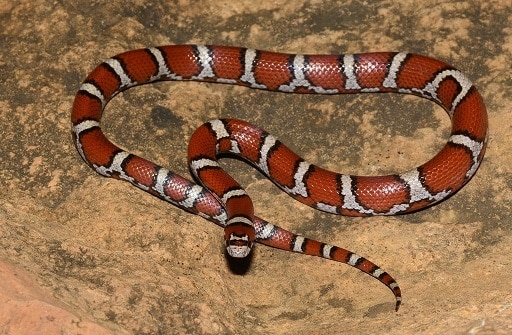
Scarlet kingsnakes belong to the huge snake family of Lampropeltis. This includes 46 species across the Americas, including the milk snake (Lampropeltis triangulum), which is itself vast, with 25 different subspecies, the most common being the eastern milk snake.
For decades, scarlet kingsnakes were considered to be the 26th milk snake subspecies. Milk snakes also possess beady eyes and black, white and red banding, with the same order. But several clues contradicted this thinking, as scarlet kingsnakes were easily the smallest “subspecies”, at 40cm versus 60-100cm. Their diet was by far the most skink-heavy, and the eastern milk snake’s face is smattered with white. The red bands are duller, and the bands also have different proportions.
Consequently, the scarlet kingsnake was split off in 2009 and became its own full species: Lampropeltis elapsoides. The furthest north scarlet kingsnakes extend to is southern Virginia, while their western flanks reach southeastern Louisiana. Milk snakes generally live further to the northwest.
| 10 | Lays eggs in rotting bark as well |
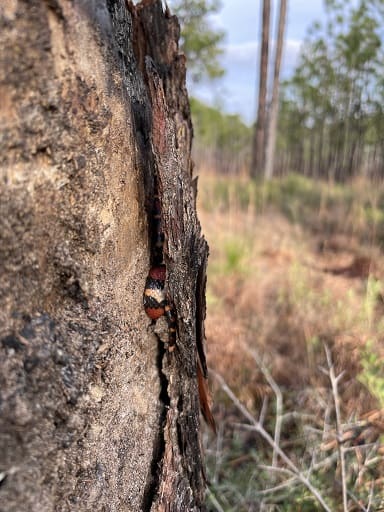
Scarlet kingsnakes always grab their lizard prey headfirst. One study examined their lizard prey like ground skinks. They found that in 5 of the 5 cases when scarlet kingsnakes grabbed them tailfirst, that tail snapped off and the lizard dashed to freedom, ready to regrow the tail slowly.
Scarlet kingsnakes are an egg-laying species, with numbers varying from 4-12. The rotting bark they hide in is a perfect place to stash their unborn children, and they also bury them several inches deep in soil. The eggs are white, elongated, and stick together slightly. Scarlet kingsnakes are also a longer-lived snake than average, despite their small size. The record in captivity was 22 years and 4 months.
Another handy mimic tip is that the empire of scarlet kingsnakes reaches much further north than eastern coral snakes, even into Kentucky and Tennessee. Another confusing similarity is that both species have smooth, glossy scales, which you can stroke without pain (except when they get annoyed and bite you).
